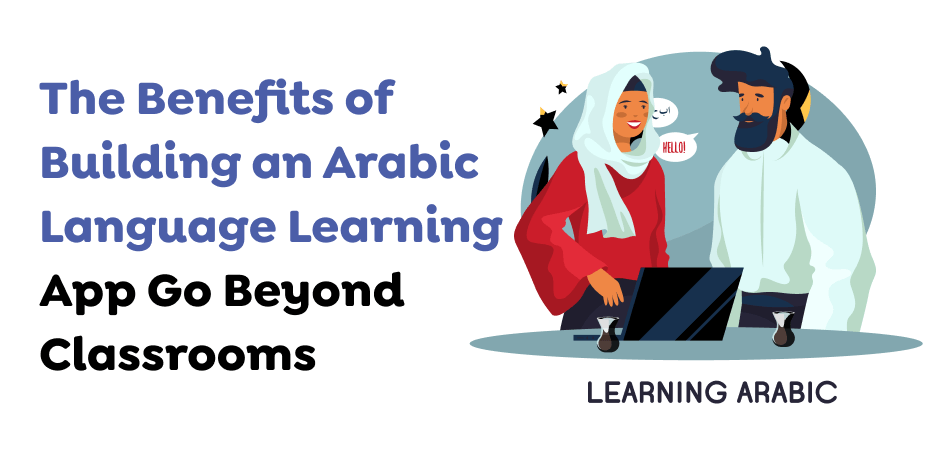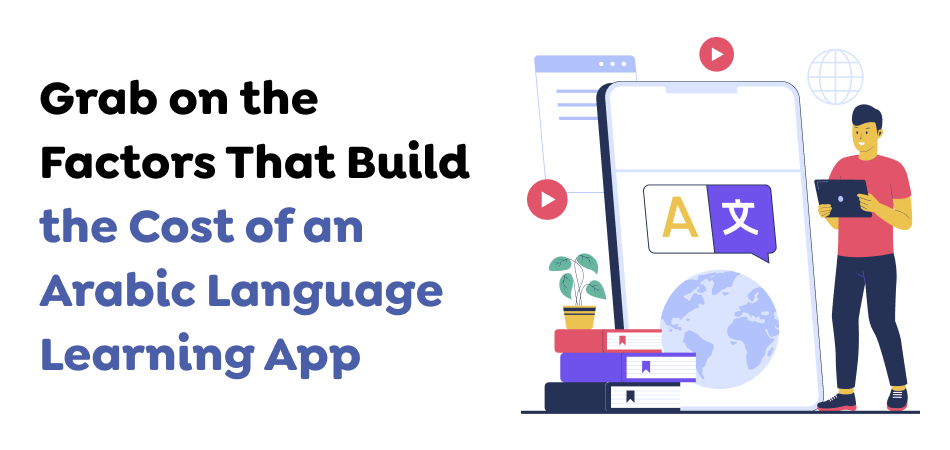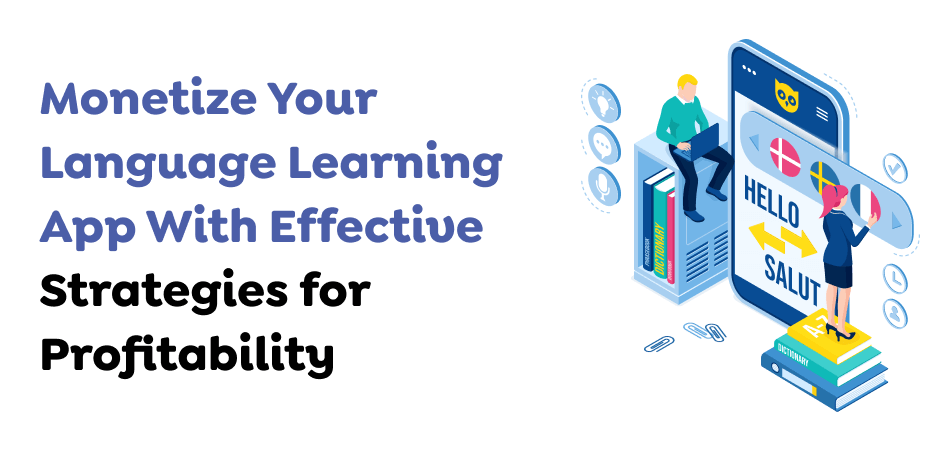Write Us
We are just a call away
[ LET’S TALK AI ]
X
Discover AI-
Powered Solutions
Get ready to explore cutting-edge AI technologies that can transform your workflow!


Are you thinking of learning the beautiful Arabic language? Since its advent, Arabic music and melodies have mesmerized hearts and minds alike, but understanding its secrets remains daunting to many people. Could it be that the key to fluency may be located in your wallet? A mobile app for learning Arabic has made learning more enjoyable and accessible. According to an analysis, the global language learning app market will reach 80 billion dollars by 2028. If you’re considering creating your Arabic language learning app, expenses associated with building it might also become an important consideration.
This blog explores the costs and opportunities for creating an Arabic language learning app. Costs related to creating Arabic apps vary based on characteristics, style, and technology. If you understand all involved processes and requirements, an outstanding language learning app can be developed explicitly tailored to meet the demands of your target audience.
So, let’s get started.
The Arabic language learning app is designed to help people acquire and achieve proficiency in the Arabic language. These programs typically include a range of functions, such as online lessons, vocabulary exercises, grammar and pronunciation explanations, practices, and insights into culture.
The application for learning services in the Arabic language is designed to accommodate learners of any level of proficiency, from beginners to proficient speakers. It employs various instructional methods, like games, repetition in space, and multimedia materials, that aim to increase learners’ involvement and retention of the content.
The apps allow users to learn Arabic at their own pace and speed anytime and anywhere they like. They are accessible on a variety of devices, including tablets, smartphones, and desktops, and provide convenient and flexible learning alternatives.
Also Read : How Much Will Mobile App Development Cost in 2025?
There’s an increasing demand for Arabic throughout the globe. An attractive online Arabic program for language acquisition could make money from this interest. Some of the most notable benefits associated with Arabic language learning app development for learning languages include:

Traditional methods may feel rigid. An app designed to aid in Arabic language instruction employs gaming, multimedia features like audio lessons or videos, and personalized courses for learning. When you develop the best Arabic language learning app that caters to various desires and goals and offers the ability to help make learning Arabic fun and a participative learning experience.
The app that helps you master the Arabic language gives people the chance to master Arabic anytime, anywhere, on their schedule. Small, short bursts of instruction can rapidly increase a considerable amount of time during an hour of commute or even waiting in line.
Knowing Arabic is not just about understanding syntax and vocabulary; it’s about building cultural awareness. A language learning application that incorporates cultural insights and real-world scenarios to help users understand Arabic and connect with people who speak the language.
Many Arabic dialects are in existence. The application could allow the user to learn Modern Standard Arabic (MSA) or other dialects depending on the individual’s academic demands. Individuals or business travelers looking to establish relationships with groups of Arabic speakers might find this particularly beneficial.
Learning Arabic using an application is more valuable than a traditional class environment. The app’s development service provider makes it feasible for a larger population, so some might require more money to participate in conventional classes.
Students can reap the advantages of earning a level certificate based on their commitment to studying different languages. These authorized institutions and experts will issue certifications and marks to students who can use them to further their learning as they require.
Also Read : Finding Faith in a Busy World: Explore How Islamic Educational Apps Can Help
It’s pretty thrilling to build a learn Arabic app; however, it can take time to identify suitable instruments or materials. You don’t have to worry; these features will make your app an effective Arabic language learning tool!

The chatbot that AI powers must be able to recognize natural language inputs and provide specific responses to user questions. The chatbot should provide interactive dialogues that mimic real-life interaction with the target language and help users improve their understanding and speaking skills. In addition, it must evaluate users’ performance and give them individualized feedback to improve their learning experience.
Students can participate in authentic scenarios such as taking restaurant food orders or exploring a new city. Simulations like these should offer opportunities for students to develop their language skills in a context that improves language retention and proficiency. Engaging in virtual conversation using AI avatars and virtual field trips in foreign places can enhance the immersion experience.
The algorithm that adapts to learning needs to examine users’ performance to tailor the learning experience. The algorithm should be able to dynamically alter the level of difficulty for exercises and suggest relevant information based on the users’ strengths, weaknesses, and preferences for learning. By adjusting assessments and focusing intervention, the application can keep users active and engaged as they progress toward their language learning goals.
Also Read : Pioneering Education: The Evolution and Future Prospects of EdTech Mobile Apps in the UK
The tracking of progress feature must give users a detailed overview of their progress in learning, such as information on lessons completed, the amount of time they spend studying, and levels of proficiency in various proficiency areas of language (reading and listening, writing, and speaking). Users can define goals, be provided with periodic progress reports, and monitor their progress over time. In addition, the application can analyze data to pinpoint those areas that require extra assistance or training.
The speech recognition feature will accurately evaluate the users’ speech and intonation by comparing their speech patterns to the patterns of native speaking. The real-time feedback feature should assist users in recognizing pronunciation mistakes and increasing their fluency in speaking.
The advanced algorithms examine prosody accuracy, phonetic accuracy, and accent reduction strategies and provide specific exercises to aid in improving pronunciation. In addition, the application can provide dialogues and speaking exercises to improve conversational skills within a safe and supportive setting.
Introducing multilingual features allows users to switch between different languages to view content in their preferred language. This feature assists the app users with diverse backgrounds and ensures that they’re included within the application’s user base. It enhances the user experience and creates a global community for learning.
Gamification features should be integrated into the app to increase participation and encourage users to make achievements. Points, badges, and endearing systems can encourage learners to finish their lessons at each milestone and participate in competitions. Social and leaderboards are a great way to create community and friendly competition between learners. Using game mechanics, such as achievements, quests, and unlockable content, this app will make language learning fun and addicting for all users.
Users can download content like courses, classes, and lessons onto their devices without internet access through offline modes. This option ensures constant learning regardless of Internet access, which can be highly beneficial for students who reside where Internet access is not as good or prefer to study at their own pace.
Based on the user’s data and preferences, the best app to learn Arabic personalized recommendations function offers suggestions on exercises, lessons, and topics suitable for the individual’s needs and proficiency. By providing content that is specific to the individual’s preferences and needs, this customization boosts enthusiasm and participation while also assisting in the effectiveness and efficiency of instruction in the language.
Also Read : What is the cost to build a mobile app in the UAE?
The cost to develop a mobile app for Arabic language learning typically ranges from around $8000 to $25000, but the exact amount will depend upon the customer’s requirements. The cost of developing mobile apps will vary with the length of time and other important factors, and they aren’t identical.
It estimates the costs to develop an Arabic application for learning languages. The cost range could be greater or lesser based on the level of technology and the functionalities and features employed. Additionally, other variables can impact the price of developing apps that teach languages. That’s why it’s crucial to examine an analysis. It’s best to talk with an experienced Android app development company to receive an exact cost estimate for creating a language learning application.
The app for learning languages relies upon various features and functions that help students achieve their learning performance. In conjunction with the app’s complexity, these functions decide the costs of creating an Arabic learning app for language. Below are the main elements that affect the app’s language development costs.

In designing an Arabic program to learn Arabic, one of the most crucial aspects that significantly impacts the expenses of developing it is compatibility with the platform and the target device. Identifying which platforms the app is available for download, like iOS, Android, or both, is crucial. Each platform has specific requirements for development, and ensuring compatibility across platforms may make it more expensive to develop the app for educational purposes.
If, for example, you intend to develop a platform accessible on both iOS and Android, a mobile app development company in Saudi Arabia must allocate funds to build and test the app for every platform. This requires coding and optimizing the app’s functionality, features, and user interface per the requirements of the respective platforms.
Additionally, considering the intended device is vital to enhance user experience. Students from countries in the developing world are likely to use smartphones and tablets. It is crucial to ensure that the application is designed to work with different sizes of screens, resolutions, and functions and that it is cross-platform compatible.
This will require additional efforts from the development team to modify the design and user interface for different platforms and devices, which can result in a higher development cost. It is also essential to remember that accommodating different platforms and devices could require more resources and time and can increase the overall cost of creating an Arabic language learning program.
When developing a language learning application, you must consider the localization process and support for multilingual languages. Multilingual support refers to the capability to provide support for multiple languages in one application or product. This is accomplished by translating the contents into different languages or providing a user interface allowing customers to pick the preferred language.
Support for multilingualism and localization are key factors affecting the expense of developing the apps that teach languages. The variety of languages apps can support will enormously influence development costs. Furthermore, the difficulty of the localizing process will impact the price. In particular, applications that require support for right-to-left languages (such as Arabic and Hebrew) will be more costly to localize than apps with left-to-right support (such as English and Spanish).
Implementing localization and multilingual support will require additional education app development effort, including content translation, cultural adaptation, and interaction adjustments. Although this could increase development costs, it would dramatically improve the user experience and increase customer engagement, creating a personalized customer experience.
Another critical factor affecting the cost to develop an e-learning app is the layout of the application. Its UI and UX design are crucial in creating an enjoyable and logical learning experience for students.
For example, to successfully create an Arabic application for learning languages, the UI style must be appealing to the eye, easy to use, user-friendly, and straightforward. This requires careful selection of the right colors, fonts, and layouts to make an appealing and visually pleasing interface that appeals to users. The UX design can increase user engagement rate and happiness in the design process by ensuring seamless navigation, easy-to-follow directions, and engaging elements.
Highly skilled designers and user-experience experts are required for wireframing and mockups of design and then iterating the app’s design elements according to user feedback. This could increase the expense of creating a learning app in a similar foreign language.
Investing in a properly designed UI and UX could significantly influence the application’s effectiveness and popularity when considering the language learning app development procedure. However, it’s important to weigh the sophistication and cost and ensure that the style is compatible with the expectations and tastes of your target audience while considering the total cost of developing an application.
Integrating external applications into a language learning app will significantly enhance its features and users’ experience. Incorporating payment solutions allows users to in-app purchases to access premium features or subscribe. Integrating social media websites lets users communicate their achievements and progress with their peers, creating an atmosphere of belonging.
In addition, integrating third-party APIs for services such as machine translation or speech recognition can enhance the application’s capabilities. In addition, integration with these services with external APIs requires extra effort to develop a language learning app that includes API integration, security, and compatibility tests. Though it can affect the costs of creating an app for learning languages, it also adds value and improves user experience.
Also Read : E-Learning App Development Cost: How to Determine the Final Sum?
In determining the language learning app’s development cost, a key aspect to consider is developing the backend and integrating databases. To develop a language-learning application, it is necessary to create a robust backend infrastructure capable of handling information about the users, their progress, and content delivery. It involves implementing and designing reliable databases and APIs to ensure that the app’s front end is in seamless communication with the application’s front end and the server.
For example, let’s say you want to build an Arabic learning application with personalized suggestions, progress tracking, and collaborative learning options. In that scenario, you require an organized database to store the user’s profile, educational materials, and progress information. The backend must be capable of processing multiple user requests and delivering the content to users seamlessly across various platforms.
Database integration is essential in education app development since it influences the speed and capacity of app development. Selecting the appropriate technique for database integration and optimizing database queries are crucial to the efficient retrieval of data and storage. You can choose between SQL and NoSQL databases based on your app’s needs and the anticipated number of users.
Furthermore, a custom language learning app may require further backend features, such as integration with third-party services such as payment gateways, payment processors, or social networks. Each integration increases the complexity of the backend design and can increase the cost of developing an app for learning languages.
The price of developing an app for learning languages will also be influenced by the type of elements you’d like to include in the application. The features you choose to include significantly determine the complexity and effort needed to develop them. For example, let’s say you plan to offer an interactive learning experience that includes games, speech recognition components, or virtual immersion experiences.
In this case, the development team must put more effort and time into incorporating these functions within the app. The features will require advanced technology, including natural machine learning, language processing, and augmented reality.
In addition, features such as adaptive learning algorithms, personal suggestions, and even progress-tracking systems require sophisticated algorithms and data analyses. To implement these features, you need an understanding of data science and AI, which can add to the development costs of the app that teaches languages.
Additionally, creating customized software for learning languages may require special features tailored to users’ demands or the languages they want to learn. Creating new features for custom purposes adds difficulty. It takes time to build, which can affect the overall price.
Arabic Learning apps for languages require several phases, and testing and quality control are crucial factors influencing the development price. While developing an app, it is vital to establish a thorough testing system to ensure its usability and reliability. Testing thoroughly helps uncover and correct bugs, glitches, or issues to ensure a pleasant user experience. The app can be optimized for efficiency and identify issues through several rounds of tests during the design procedure.
Maintenance and updates are other significant aspects that influence the app’s development cost for learning languages. Once an app has been introduced and launched, its success and user satisfaction must be ensured through regular app maintenance. It includes fixing bugs, implementing security patches, and optimizing the performance.
In addition, an eLearning app development company performs regular updates to add new features, improve current functionality, and integrate users’ feedback. Suppose you are actively updating and maintaining your app. In that case, you can ensure it is relevant, competitive, and in tune with your customers’ changing requirements.
Also Read : Step-by-Step Guide for Mobile App Development Process
Developing a highly successful language-learning program requires careful preparation and implementation across many vital steps. Below is a step-by-step guide to lead users through the steps:

The first step is to determine the intended users of the application for learning languages, then focus on the target group and their unique needs for learning languages. Recognizing their needs can help create the elements and contents accordingly.
Concentrate on developing an attractive and simple interface. Make mockups to showcase the application’s layout, key elements, and user flow. Create a user-friendly and seamless journey from initial onboarding through advanced classes.
Choose the languages and frameworks most suitable for your app’s requirements. Consider factors such as scalability, security, and compatibility with different devices (Android, iOS). Use modern technology to create an efficient and robust application.
Incorporate essential features, such as Interactive lesson modules, fun words-building exercises, tools for memorization, and progression tracking tools. They will help keep learners interested and help them monitor their progress in learning.
Integrate other services, such as speech recognition APIs that allow pronunciation exercises, translators who provide real-time help, or content libraries curated with additional learning tools, to make your app more functional.
Next, test the app across various platforms and devices to ensure compatibility, efficiency, and error-free experience. Find any inconsistencies or problems that arise during testing to ensure a pleasant user experience.
Before commencing the submission process, ensure your app complies with all rules set by the app store. Optimize your app’s metadata and description of screenshots and other information to draw potential customers.
Invite users to comment and critique to help you understand the experience. Review the feedback you receive and then use it to update your app to address issues, enhance capabilities, and improve overall customer satisfaction. This process ensures that the app is current and useful for users.
Also Read : Essential Features for a Robust e-Learning App Development!
The app market for learning languages is expanding; however, with all the options available, what can you do to ensure that your app is distinctive and earns a profit? These are the most effective methods to earn money through language learning apps:

The famous model provides the basics of learning as well as accessible functionalities. It allows users to feel the benefits your application offers. It encourages them to upgrade to get a better learning experience. Premium tier users can access new languages, more sophisticated lessons, customized learning plans, downloadable content advancement tracking capabilities, and unique benefits.
Through the subscription model, users pay monthly (each quarter, monthly, or even annually) for access to your application’s maximum potential. This provides a steady income stream and also encourages ongoing engagement. The subscription plans are scalable, with different service levels depending on users’ needs. For example, a base plan may offer access to the core curriculum, and a higher-end plan may include lessons. These games are interactive and require a certificate of completion.
Offering in-app purchases allows users to concentrate on particular aspects of their education. This could be a series of lessons in business vocabulary grammar, grammar practice focusing on a specific verb, or customized pronunciation programs. Additionally, you can provide consumables such as boosters for lessons or points to enable additional challenges or content inside the application.
Though intrusive ads may disrupt the learning process, carefully targeted, non-disruptive advertising could be an effective source of revenue. Join forces with companies that offer goods or services related to language education, such as translators, travel apps, and online dictionaries. This way, your users will be exposed to ads supporting your learning objectives, and you will earn revenue.
Join forces with businesses that provide language-learning resources and study abroad programs. Advertise their services or products in your application and earn a commission on each successful recommendation. This is an opportunity for both parties, as you offer users valuable tools and earn additional revenue.
Developing an Arabic language learning app has several advantages. The app allows users to study any language, anytime, anywhere, and at any location, which is ideal for hectic lifestyles. In the age of globalization and an increasing demand for multilingual proficiency, this app could be a popular choice for users. This app offers the chance to make a difference in language learning through advanced technology like AI gaming, gamification, and personalized learning experiences.
The process of creating applications has the same set of difficulties. Producing high-quality content in different languages demands significant time and experience. Working with a mobile app development company in Dubai helps businesses tackle these issues effectively while providing benefits such as expert knowledge in efficiency and efficacy and information about market trends. Through collaboration with the appropriate business partner, they can build an app for language learning that meets users’ needs and has a long-term impact on the highly competitive app market.
Techugo, a leading mobile app development company in Dubai, is the ideal partner for creating an Arabic language learning app. With a proven track record of delivering innovative and high-quality solutions, Techugo’s expertise in app development, coupled with their deep understanding of the Arabic language and culture, makes them the perfect choice. Their team of skilled developers and language experts can ensure that the app is culturally relevant, engaging, and effective in teaching Arabic. By partnering with Techugo, you can leverage their expertise to create a truly exceptional language learning app that stands out in the competitive market.
So what to wait for? Get in touch now!
Write Us
sales@techugo.comOr fill this form